This is an Argus A-Four, a 35mm viewfinder camera produced by Argus in Ann Arbor, Michigan between the years 1953 and 1956. The A-Four would have taken place in Argus’s lineup formerly occupied by the A-series with the last model being discontinued in 1951. It was an all new camera with a mostly plastic body with metal trim, a 4 speed German shutter made by Gauthier and a 44mm f/3.5 triplet lens. The specifications of this camera, along with the design of the lens are suspiciously similar to the Kodak Pony 135 which would have been it’s nearest competitor. Despite it’s simple feature set, like the Kodak Pony, the Argus A-Four was capable of good photographs and would have been ideal for color slide photography which was growing in popular in the mid 1950s.
Film Type: 135 (35mm)
Lens: 44mm f/3.5 Argus Coated Cintar coated 3-elements in 2-groups
Focus: 2.5 feet to Infinity
Viewfinder: Scale Focus
Shutter: Gauthier Leaf
Speeds: B, 1/25 – 1/200 seconds
Exposure Meter: None
Battery: None
Flash Mount: Argus Flash Gun
Other Features: None
Weight: 340 grams
Manual: https://www.cameramanuals.org/argus/argus_a-four.pdf
How these ratings work |
The Argus A-Four was targeted as a competitor for the Kodak Pony to complete for the buying dollars of American families looking for easy to use cameras that could shoot good quality color slide and negative film. The target customer would have been someone who expected good images, but without the need to understand a great deal about photography. The A-Four mostly meets those goals in an easy to use and attractive body. The camera falls short a bit on image quality and despite being the norm for early 1950s cameras, has an unfortunately small viewfinder which limits it’s usefulness for people with glasses. | ||||||
| Images | Handling | Features | Viewfinder | Feel & Beauty | History | Age | |
| 1 | 1 | 1 | 1 | 1 | 0 | 30% | |
| Bonus | none | ||||||
| Final Score | 6.5 | ||||||
History
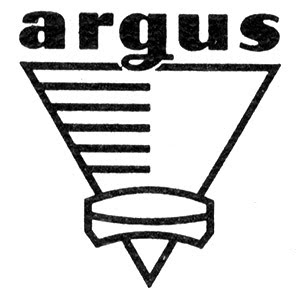 I’ve covered Argus many times on this site. From the company’s early days as the International Radio Corporation making the A-Series Arguses, all the way to the Mamiya made Argus SLR, I’ve covered much of the company’s history.
I’ve covered Argus many times on this site. From the company’s early days as the International Radio Corporation making the A-Series Arguses, all the way to the Mamiya made Argus SLR, I’ve covered much of the company’s history.
When you look at the company’s entire history as a whole, one thing becomes clear, which is that the company’s greatest success likely was their biggest weakness. The Argus C-series, starting with the original Argus C from 1938 to the Argus C3 Match-Matic produced through 1966 was clearly the company’s best selling and most widely recognized model.
But in those 28 years of building what ultimately became the most successful American camera ever made, it seems as though Argus couldn’t get out from under their own shadow. Over the course of nearly thirty years, Argus would make new models, many of which where more advanced, had a longer list of features, and much better ergonomics than the rudimentary pre-war design of the C3 “brick”, yet, each time a new model like the C44 or C44R or even the Argus SLR was produced, those models would be discontinued while the C3 kept being made.
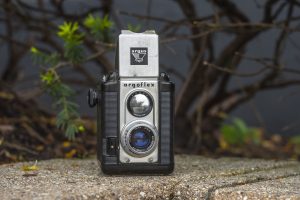
It seems to me Argus was aware that they needed to update the C3, but they didn’t seem to know how to do that, and make a camera that would sell as consistently as their most popular model. By my count, there were a total of thirteen 35mm cameras and another nine 120/620 twin lens reflex cameras, plus a spattering of 828 and 127 camera models released in between the first and last C-series models. Several of these cameras had specs and features that should have made them ideal replacements for the aging C-series, but it never happened.
Why was Argus so successful with one particular family of camera, yet each time they attempted to improve it, they couldn’t sell them in large enough numbers? Was it poor marketing or distribution, was it that people just REALLY liked pre-war brick shaped cameras, was it some kind of corporate blindness to change, or was it something else entirely, who knows?
As a whole, Argus had a knack for making good, but not great, affordable cameras. Like Eastman Kodak, Argus had a knack for extracting good value from not much camera. Cameras with plastic bodies, simple three and four speed shutters, and triplet lenses were the company’s bread and butter. The Argus Seventy-Five sold well and made images on par with entry to mid level German and Japanese cameras. The Argus C4 and C44 models were quite nice, with comfortable ergonomics, interchangeable lenses, and quality rangefinders, offering value that more expensive Leica and Contax cameras couldn’t come close to matching.
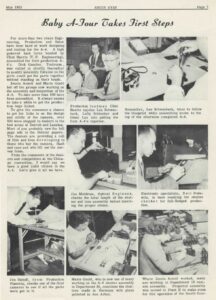
One model, that seems to be very overlooked was a simple camera called the Argus A-Four. Originally referred to as the A-4, this replacement for the original A-series was in development for two years before it’s release in the spring of 1953. According to a short article which appeared in the May 1953 issue of Argus’s company newsletter, Argus Eyes, the development of the A-4 was led by Argus Vice President of Engineering, Clint Harris. The camera was announced to internal employees in 1952 with an official debut set for a photography trade show in Chicago in the spring of 1953.
The A-4 represented the first new 35mm camera designed from the ground up since the Argus C from 1938. Despite sharing a name similar to the original A-series, it shared nothing in common with those earlier cameras, featuring all new everything.
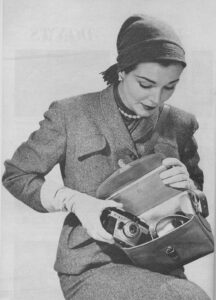
In what was a common practice among camera designers of the mid 1950s, the Argus A-Four was designed as a ladies camera. While it wasn’t made exclusively for women, it is clear that a lot of effort was made with women in mind.
Argus, along with other companies like Eastman Kodak and Zeiss-Ikon, studied the buying habits of women, and attempted to find correlations between their preferences and how consumer products like cameras would be created and marketed.
In the Feb 15,1954 issue of the Photo Dealer Directory Issue, on page 32 was an article called, “The Buying Behavior of the American Female” which says:
Manufacturers conducted surveys to determine the importance of women as customers. Publicity releases issued by Argus Manufacturing Co. stress the selling value of light-weight cameras, smartly styled and easier to use to “meet ladies’ requirements.”
Dudley J. Scholten, vice president and director of sales and advertising at Argus, predicted that the camera of tomorrow will be operated by women. He expects outright distaff dominance of the amateur photo field within a few years.
“Even today,” he said, “the newest cameras show that manufacturers are following the producers of automobiles in designing products to appeal to feminine taste.”
Fun Fact: The Argus A-Four would not be Argus’s first attempt at designing a camera with women in mind, as in the 1960s, the camera would produce the Argus Lady Carefree, a cheap plastic camera with a paisley body covering that was marketed directly to women.
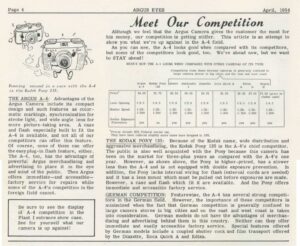
In the mid 1950s, Argus would open an international office in Stuttgart, Germany, with the intent of developing new models there at a lower cost than could be done in the US. While the development of the A-4 predates that initiative, it is clear that Argus had some kind of relationship with German camera makers as the shutter on the A-4 was designed by Gauthier in Calmbach. Likely a simplified variant of AGC’s Vario shutter, Argus’s new camera would sport a German shutter, but American made three element coated 44mm f/3.5 lens.
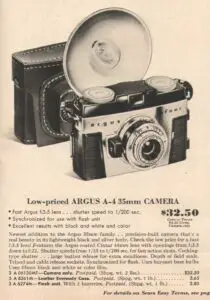
Curiously, after it’s release, the new Argus would compete directly with Eastman Kodak’s Pony 135 camera which had a very similar list of features, including a 44mm lens and similar shutter. One big difference however, was that at the time, the Pony had a slower f/4.5 lens. Later on in the Pony’s life, Kodak would refresh it with a Model C variant that had a faster f/3.5 lens, possibly in response to the Argus A-Four.
The Argus was sold across the Midwest United States at Argus dealers and also through the national department store chain, Sears, Roebuck, & Company. The ad to the right is from a 1955 Sears catalog showing the Argus A-Four for sale for $32.50 by itself with a leather case and flash unit for an extra $3.65 and $3.80 respectively. When adjusted for inflation, these prices compare to about $365, $41, and $43.
In an Argus catalog that was sold at Argus dealers, the company wisely avoided the distinction of the camera being designed for ladies, instead referring to it as the “Greatest 35mm Camera Value in Years”. Comparisons made to box cameras suggest a camera with more flexibility, ease of use, and the fastest lens in it’s class. The suggested prices for the camera, case, and flash matched that from the Sears catalog suggesting these were factory set prices.

Throughout it’s life, the Argus A-Four changed slightly and there are three known variants of the camera, all relating to the focus scale, shutter speeds, and aperture markings on the front of the camera.
- Version 1 – Through January 1954 – No Colormatic settings for focus. Shutter speed 1/100, aperture f/8, and 15ft marking on the focus scale are in red. Shutter speed 1/25 is in green to indicate flash setting. Shutter speeds printed at the bottom of the front face of the shutter. Minimum aperture is f/16 and minimum focus is 2.5 feet.
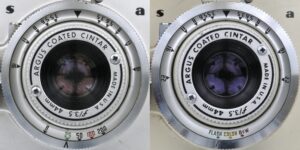
This image shows the shutter faces of the Argus A-Four, Versions 1 and 3. - Version 2 – January 1954 to Mid 1955 – Colormatic settings on the focus scale. Yellow and a red dot on either side of the 15ft marking. Aperture f/8 is in red and there is a yellow dot between f/8 and f/5.6. Shutter speeds on front face of shutter are replaced with “Flash” in green (1/25), “Color” in yellow (1/50), and “B&W” in red (1/100). No Bulb setting, minimum aperture is f/16, and minimum focus is 2.5 feet.
- Version 3 – Mid 1955 and Later – Same as Version 2, except minimum aperture is now f/22 and minimum focus is 2 feet.
Records indicate that the Argus A-Four was produced until 1956, but may have been available as new old stuff for a year or two later. No sales numbers were produced, but the camera appeared to be less popular than it’s primary competitor, the Kodak Pony.
Whatever struggles the A-Four might have had in the market, likely had nothing to do with any shortcomings to the camera itself, as on paper, it compared very favorably to the Kodak camera, but more than likely the overwhelming influence Eastman Kodak had as a camera and film maker, plus increasing financial troubles at Argus likely doomed it.
Today, few Argus cameras are sought after outside of dedicated collectors for the brand. The Argus C-series is without a doubt the camera maker’s most popular model, with it’s medium format TLRs, twin lens box cameras, and interchangeable lens C-4 and C-44 series being the brands most desirable models. The simple, yet attractive Argus A-Four simply doesn’t attract much attention these days, which is a shame, as it is a good looking camera with distinct styling and a competitive (for it’s segment) feature set.
My Thoughts
It is no secret that I have a soft spot for Argus cameras, specially the Argus C3. Of all the reviews I’ve written on this site, my review for the entire Argus C-series came in at over 12,000 words, making it the longest review I’ve ever written, and on Episode 27 of the Camerosity Podcast where the guys and I talked about desert island cameras we’d want with us if stranded on a desert island, I picked the C3 as my camera of choice for it’s ruggedness, reliability, and quality images it makes.
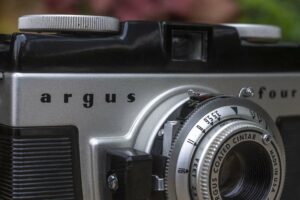
With such a fondness for Argus and their cameras, I’m always on the lookout for some of the company’s other models, and while I’ve had many opportunities to shoot the C4, C44, C33, the Argus SLR and multiple versions of the A-series, the little Argus A-Four was one model that eluded me.
Unofficially a replacement for the A-series, this simple and lightweight camera is quite attractive. It might even be the prettiest Argus camera ever made. When I finally got my hands on one, I remarked at how solid it feels. While it sparingly uses metal in it’s construction, a majority of the body is Bakelite which adds a similar amount of heft as in the C-series. The camera has a design and feature set similar to the Kodak Pony which I adore, so I figured this camera would be a lot of fun to shoot.
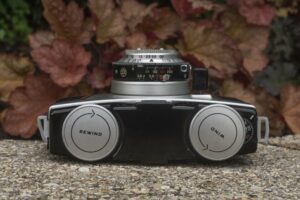
Up top, there’s no mistaking this is a simple camera. With two very large knobs, one marked Rewind and one marked Wind, the two knobs do as their labels describe. The Rewind knob turns freely in both directions, but the Wind knob is geared to only spin in the direction of the arrow. Like the Argus C-series, the film advance has a lock which prevents you from over-winding the camera, but must be manually released before advancing the film to the next image. Beneath the right side of the Wind knob is the additive exposure counter, which shows how many exposures have been made on a roll. The counter must be manually reset after loading in a new roll of film.
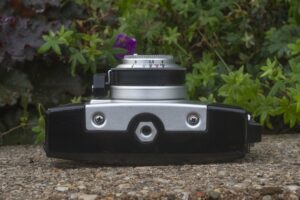
Hold the camera upside down and on the bottom you’ll see the centrally located 1/4″ tripod socket. Although the A-Four does have a Bulb mode, I can’t imagine too many people would have used this camera for long exposures. There’s nothing else to see here other than two screws which hold the metal front plate onto the camera.
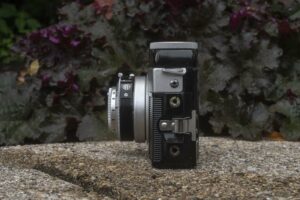
The camera’s left side is unusually cluttered, featuring two circular ports for mounting the Argus flash gun made for this camera, and then in the center, a metal clip which is used to hold the back of the camera secure to the body. When it comes time to open the camera, simply pry back on the clip and the entire door will come off. On both sides of the camera, near the tip are two metal loops for connecting a neck strap to the camera. While the A-Four is not a heavy camera, being able to have it ready around your neck for spontaneous snapshots was a nice benefit.
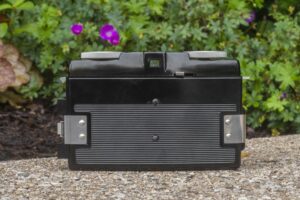
Around back is the small rectangular opening for the viewfinder. Although not as small as other cameras of the era, for a simple viewfinder camera, it is mildly disappointing Argus couldn’t have found a way to make it larger. To the right of the viewfinder is a small lever which is used to unlock the film transport. This must be used both while advancing and rewinding the film. Simply press and hold the lever to the right whenever you need to move the film in either direction.
The back of the door has two metal clips on each side. The one on the left must be pulled up to remove the door, and the one on the right simply wraps around and holds onto a small ledge built into the plastic body.

After prying back and lifting on the door release, the entire back of the camera comes off. The film compartment is made almost entirely of plastic. The only metal bits are the geared wheel for detecting film perforations, the cassette fork, and a small metal plate beneath the take up spool. Film transports from left to right on a thin and non-removable plastic take up spool. Through the center of the spool is a zig zag slit in which the film is inserted and upon turning the advance knob a couple of revolutions, grips the leader just enough to prevent it from slipping out. It’s a rudimentary design, but does work. There are no rails above or below the film gate, so film just glides across the plastic as it is transported. The inside of the film door has a small and unpainted metal film pressure plate. There are no other rollers or springs on the inside of the door to help maintain flatness on the film as it moves through the camera. The door has no light seals of any kind. Rather, a thick border around which rests in a similar size channel around the perimeter of the film compartment, keeping light from leaking on the film. Like the take up spool, it is a rudimentary design, but it gets the job done.
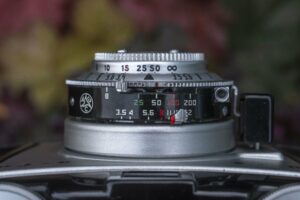
Looking down upon the top of the shutter, we see scales for the aperture, shutter speed, and focus distances. Closest to the body, f/stops from f/3.5 to f/22 are shown with f/8 in red, shutter speeds from 1/25 to 1/200 plus Bulb, with 25 in green and 200 in red, and finally focus distances from 2.5 feet to infinity with 15 feet in red. Each of the three red settings are to be used together when using the Argus A-Four as a snapshot camera outdoors, where the depth of field is sufficient to capture nearly every type of scene you could want to shoot, assuming the light is good enough.
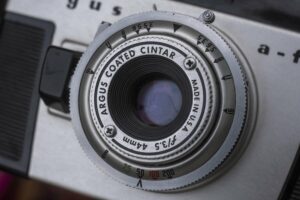
Directly in front of the shutter speed scale is a cocking lever for the shutter, which must be moved to the left before each exposure is taken. To the right of the shutter speed scale is a threaded socket for a shutter cable release. To the side of the shutter is the rather large shutter release lever. The shutter release on the Argus A-Four has double image prevention which can only be defeated by advancing film through the camera. If you do not have film in the camera and would like to test the shutter, you must remove the film door, and then manually rotate the gear by hand.
The Argus A-Four focuses by rotating the entire front element. A complete motion from minimum to infinity focus is about 270 degrees, so it cannot be done easily in one motion, but rather requires several smaller movements. Below the lens is a duplicate shutter speed scale which shows the same settings from the top of the camera, in case you forget what it is set at while looking at the front of the camera.
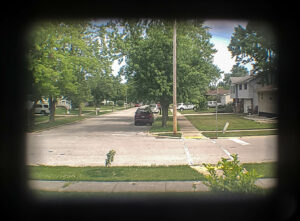
The viewfinder is just a simple straight through optical design. There are no frame lines or any other indicators of the camera’s settings. The viewfinder is rather small and is impossible to see all four edges while wearing prescription glasses. While tiny viewfinders like this were still the norm in 1953 when this camera was released, it always surprises me how long it took the photography industry to collectively get the message that they need to make the viewfinders bigger. The Argus A-Four was never going to be a high spec camera, but it’s usability could have been dramatically improved with a slightly bigger viewfinder and maybe some frame lines.
During the era in which the Argus A-Four was made, the company was still selling quite a few of their Argus C3 models. While the company relied heavily on the success of that model, they had to realize that coming up with new products was essential. Argus knew their target customer were American families who wanted snapshot cameras, so releasing a simple and easy to use camera like the A-Four likely made sense, but was it enough? How was it like to use and what kinds of images did it make? Keep reading…
My Results
When cameras like the Argus A-Four came out, slide film was extremely popular in the United States and film stocks like Kodachrome were very commonly shot. In the 1950s, Kodachrome had a speed of ASA 12, which was improved in 1961 to ASA 25. Kodachrome, unfortunately no longer exists as the chemicals needed to develop the images are no longer made. So while I couldn’t recreate the type or look of exposures that someone likely would have shot in the Argus A-Four, I wanted to at least mimic the slower speeds of those films, so I chose my favorite ASA 25 speed film, Kodak Panatomic-X.
I have been a fan of the Argus C3 ever since the first time I shot one. In addition to it’s unique looks, strange ergonomics, and historical significance, the C3 is capable of really excellent images. The Cintar triplet on that lens is as good as any other German or Japanese triplet I’ve seen, so when I first loaded up the Argus A-Four, seeing it’s lens labeled as an Argus Coated Cintar, I expected at least similar results.

Sadly, that’s not what I got. The images from my test roll showed reasonable sharpness in the center, but things degraded quickly the closer you got to the edges. Vignetting was minor, but the amount of softness on the edges was worse than any triplet I’ve seen in a while. It was so bad, in fact, that I thought perhaps something was wrong with this camera. I did a quick external check of all the things that could go wrong in an old camera, like a loose lens, dislodged or flipped lens element, missing or damaged pressure plate, and nothing seemed out of the ordinary.
Since I didn’t have a second Argus A-Four to compare my images to, I did some searching online to see if other people who had written about this camera had a similar experience. It only took a couple seconds for me to find a post on photo.net from November 2010 by someone named JDMvW who wrote:
As the pictures show, there is a considerable loss of image quality out at the edges of the picture, but the center is decent if not looked at too closely…I was a little surprised by the lack of sharpness, too. I can’t see what would be out of adjustment on it, and the lens was clear even before I cleaned the accessible surfaces. I suppose there might have variation in quality control.
Other comments in the same thread from people who had also used an A-Four said that their results were better. Even further, the OP commented that he had some issues with his flatbed scanner that improved things somewhat with a rescan, but that the second scans still showed softness near the edges.
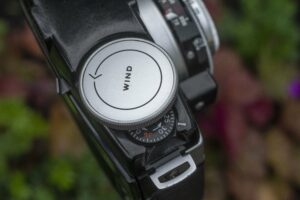
With this information, I am not ready to completely dismiss the A-Four as a capable photographic instrument, but will definitely agree that a combination of sample variation, and the fact that we’re talking about a 70 year old plastic camera, some compromises will need to be made. At the time of it’s release, Argus advertised the A-Four’s Cintar lens as the sharpest made in the United States, whether this is just marketing boastfulness, or if this is just a good example of an old camera not living up to it’s original performance is not yet something I can conclude. For anyone reading this, wondering why I didn’t shoot another roll, I felt as though doing another roll in this same camera wouldn’t produce different results, I’ll have to wait until I find another sample of this camera.
Aside from the image quality, I did not enjoy my time with the A-Four as much as I thought I would. The ergonomics were just OK. I liked the large size of the film advance and rewind knobs which made advancing the film quick and easy, but I did not like the location of the front shutter release, which I felt was located too low on the body of the camera. When holding the camera in a shooting position, the location of my right index finger is more than halfway down the front of the camera. The shutter release itself requires a bit of travel to bottom out, and when you do that, your finger is already near the bottom of the camera.
To be fair, many of the A-Four’s shortcomings are there on it’s primary competitor, the Kodak Pony, however the Pony outsold the A-Four by a huge margin and was produced for longer and saw multiple revisions to it’s design so maybe people were more forgiving of it, or maybe it’s lens performed better, or maybe they preferred the top plate shutter release.
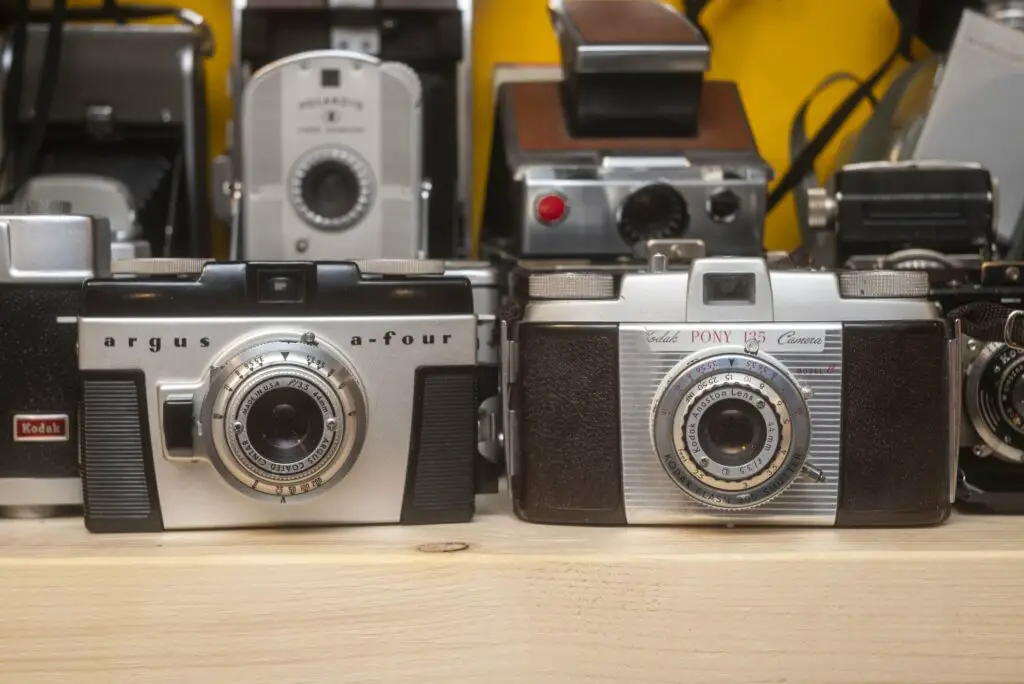
Perhaps my least favorite part of the camera was it’s tiny viewfinder in which I could not see the entire image while wearing glasses. While small viewfinders were still pretty common in 1953 when this camera was released, they quickly grew out of favor and I just have a hard time understanding how the designers at Argus couldn’t have thought “Gee, maybe we should make this a little bit bigger.”
If it sounds like I hated my time with the Argus A-Four, I don’t. I still find the camera to be very attractive, and in some sort of way, shooting images with soft edges gives it a “vintage-y” look that when used in the right circumstances, can look very cool. Maybe if I do shoot this camera again, I’ll take it out shooting cemetery gravestones, or some old dilapidated cars or barns that litter the landscapes of the Midwest United States. This isn’t a bad camera for sure, and I am sure the people who bought it when it was new, were likely happy with the results. I just didn’t love it.
Related Posts You Might Enjoy
External Links
http://camera-wiki.org/wiki/Argus_A-Four
https://blog.jimgrey.net/2010/06/07/argus-a-four/
https://filmadvance.com/2014/08/favourite-cameras-argus-a-four/
https://www.photo.net/forums/topic/416717-argus-a-four-1953-1956/


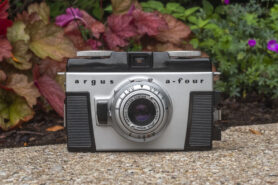
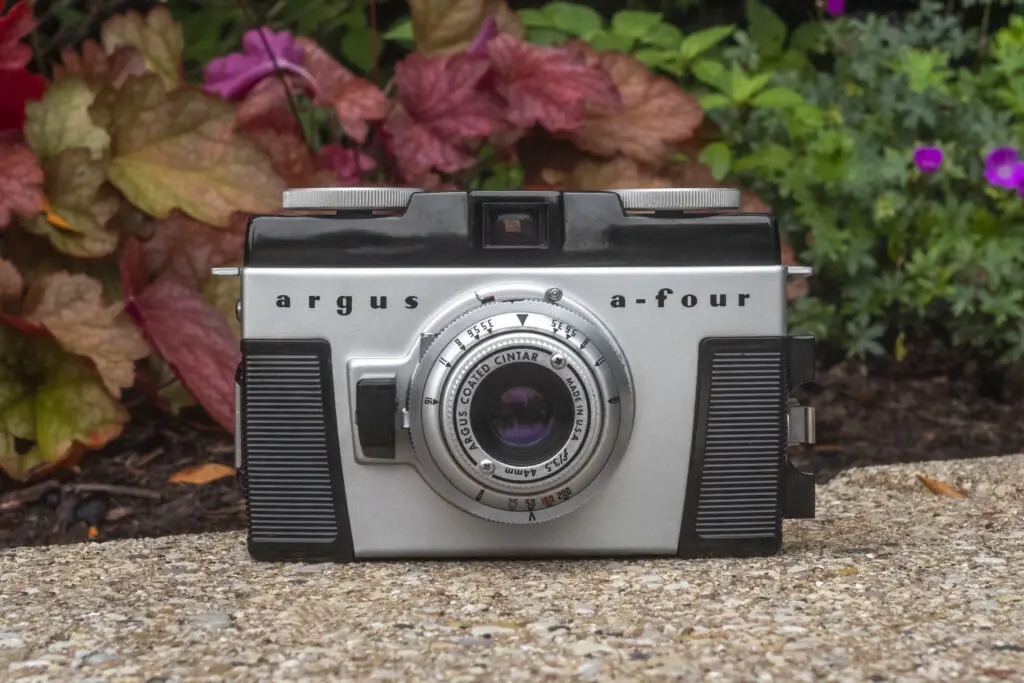











I bought an Argus C3 year ago. I love the nickname the Brick. The controls are really tight so I haven’t used since I have a lot of old cameras to play with.
One of these was the first truly capable camera I ever owned, scored at a yard sale for $5 in about 1982. I asked a friend in the photography club how to shoot it and he just said, “f/8 and be there.” So I shot it f/8 and 1/100 because I noticed both were red and figured that must mean something. Thank God for the exposure latitude of film.
The Ghost of Weegee taught you how to shoot film! 🙂
Despite being a predecessor to the A-four, you would probably like the Argus 21 Markfinder. It corrects the main two deficiencies you talked about, a bright and large for its era viewfinder with projected frame lines and the same exact lens as found on the C-3, albeit in a different mount.
The Markfinder is a model that has eluded me so far! I have seen them and can definitely see the appeal. If I ever come across one, I’ll certainly write about it!